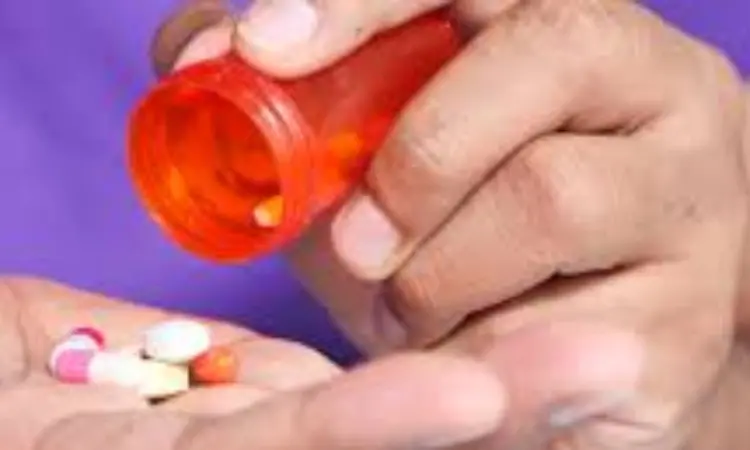- Home
- Medical news & Guidelines
- Anesthesiology
- Cardiology and CTVS
- Critical Care
- Dentistry
- Dermatology
- Diabetes and Endocrinology
- ENT
- Gastroenterology
- Medicine
- Nephrology
- Neurology
- Obstretics-Gynaecology
- Oncology
- Ophthalmology
- Orthopaedics
- Pediatrics-Neonatology
- Psychiatry
- Pulmonology
- Radiology
- Surgery
- Urology
- Laboratory Medicine
- Diet
- Nursing
- Paramedical
- Physiotherapy
- Health news
- Fact Check
- Bone Health Fact Check
- Brain Health Fact Check
- Cancer Related Fact Check
- Child Care Fact Check
- Dental and oral health fact check
- Diabetes and metabolic health fact check
- Diet and Nutrition Fact Check
- Eye and ENT Care Fact Check
- Fitness fact check
- Gut health fact check
- Heart health fact check
- Kidney health fact check
- Medical education fact check
- Men's health fact check
- Respiratory fact check
- Skin and hair care fact check
- Vaccine and Immunization fact check
- Women's health fact check
- AYUSH
- State News
- Andaman and Nicobar Islands
- Andhra Pradesh
- Arunachal Pradesh
- Assam
- Bihar
- Chandigarh
- Chattisgarh
- Dadra and Nagar Haveli
- Daman and Diu
- Delhi
- Goa
- Gujarat
- Haryana
- Himachal Pradesh
- Jammu & Kashmir
- Jharkhand
- Karnataka
- Kerala
- Ladakh
- Lakshadweep
- Madhya Pradesh
- Maharashtra
- Manipur
- Meghalaya
- Mizoram
- Nagaland
- Odisha
- Puducherry
- Punjab
- Rajasthan
- Sikkim
- Tamil Nadu
- Telangana
- Tripura
- Uttar Pradesh
- Uttrakhand
- West Bengal
- Medical Education
- Industry
Drug-induced dystonia after sacubitril/valsartan combination therapy in a 19-year-old female student: Case study

India: A recent case study published in Annals of Internal Medicine: Clinical Cases reports the case of classical dystonia in a young girl who presented with reduced systolic left ventricular function, had cardiac surgery, and was prescribed sacubitril/valsartan combination for reversal of heart remodelling.
After the stoppage of this combination in the patient, dystonia did not reoccur. Although being an effective drug for heart failure with reduced ejection fraction, "newer indications will need further assessment for the different dose regimen and adverse drug reactions," Prabhat Tewari, Sanjay Gandhi Postgraduate Institute of Medical Sciences (SGPGIMS), Lucknow, Uttar Pradesh, India, and colleagues wrote.
The fixed-dose combination of sacubitril (neprilysin inhibitor) and valsartan has revealed a significant benefit in cardiovascular death and hospitalization for heart failure with reduced ejection fraction (HFrEF) as compared with other commonly used single-drug regimens in the PARADIGM-HF trial. Newer indications for its use may include postoperative cardiovascular patients with HFrEF who may require early reverse remodelling of the left ventricle.
Usual adverse drug reactions with this combination include renal impairment and symptomatic hypotension. Adverse drug reaction by definition can be an unpleasant response due to a drug use that can adversely impact a person and may call for either treatment or withdrawal of the medication.
Dr. Tewari and the team shared the recent complication of abnormal muscular movements that started shortly after administering sacubitril/valsartan combination therapy in a young female patient during the postoperative period after cardiac surgery.
This case report may result in the further reevaluation of the sacubitril/valsartan combination for its dose regimen adjustment in newer therapeutic indications where this therapy may prove to be helpful.
The case concerns a 19-year-old female student with a height of 159 cm and weight of 35 kg who was admitted with grade III dyspnea. Upon detailed echocardiographic evaluation, she was diagnosed with severe aortic regurgitation due to the right coronary cusp prolapse, subpulmonic ventricular septal defect, and dilated left ventricle with reduced ejection fraction (40%). She was managed in the intensive care unit and was weaned off the ventilator support after 12 hours. She did well in the postoperative period and was prescribed diuretics (spironolactone–torsemide combination) and aspirin.
She was also started on low-dose sacubitril/valsartan combination therapy (total 25 mg per day), divided into 2 equal doses given twice daily for two days after her consent as she had a dilated left ventricle with moderate ejection fraction.
She was discharged from the hospital on the fifth postoperative day with a good activity level but was readmitted in the same evening with the symptoms of bouts of an extremely stiff, nonpainful neck that tilted her head involuntarily leftwards, upwards, and backwards in hyperextension. This involuntary movement resolved by itself in an hour, only to reoccur after some time and stay for a longer duration. A neurology consultation adjudged this as drug-induced acute dystonia.
Being the new drug used in this particular postoperative setting, the Sacubitril/valsartan combination was stopped and replaced with carvedilol, a beta-blocker. She responded well to this change, and the dystonic movements never occurred afterwards in the follow-up.
In conclusion, the Sacubitril/valsartan combination is an effective therapy for HFrEF patients to improve their quality of life. Its use in postoperative settings underlies the fact that this kind of adverse reaction of this beneficial drug may need close monitoring, and studies may be required to determine the mechanism of such an adverse reaction in humans. It is also important that healthcare providers are well versed with these new side effects, and reporting of these incidences is to be encouraged.
"Although being an effective drug for heart failure with reduced ejection fraction, newer indications will need further assessment for the different dose regimen and adverse drug reactions," the research team concluded.
Reference:
DOI: https://doi.org/10.7326/aimcc.2023.0131
Dr Kamal Kant Kohli-MBBS, DTCD- a chest specialist with more than 30 years of practice and a flair for writing clinical articles, Dr Kamal Kant Kohli joined Medical Dialogues as a Chief Editor of Medical News. Besides writing articles, as an editor, he proofreads and verifies all the medical content published on Medical Dialogues including those coming from journals, studies,medical conferences,guidelines etc. Email: drkohli@medicaldialogues.in. Contact no. 011-43720751


